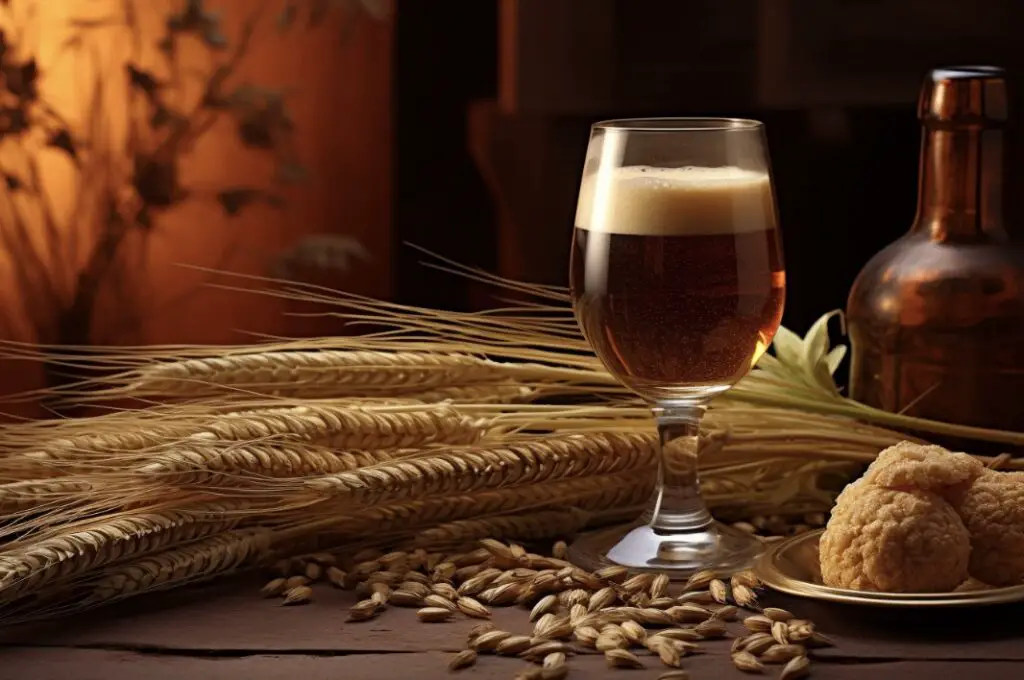Barley wine is a strong, robust, and complex beer style that has been enjoyed for centuries. One of the most important aspects of brewing a successful barley wine is the conditioning time. So, how long should you condition barley wine?
The answer is that it depends on several factors, but a general guideline is at least six months to a year for optimal flavor development.
In this blog post, we will explore the factors that influence conditioning time, how to properly condition barley wine, and how to determine when it is ready to enjoy.
Understanding Barley Wine
What is Barley Wine?
Barley wine is a beer style characterized by its high alcohol content, usually ranging between 8-12% ABV. It is a rich, full-bodied beer with a deep, complex flavor profile that often includes notes of caramel, toffee, dried fruit, and sometimes even a touch of hop bitterness.

Despite its name, barley wine is not a wine, but rather a strong ale that has been aged to develop its unique flavors.
A Brief History of Barley Wine
Barley wine has its roots in England, dating back to the 18th century. At that time, it was common for brewers to create strong ales as a way to showcase the quality of their malt. These strong ales were typically aged for an extended period before being enjoyed, which allowed the flavors to meld and develop, resulting in what we now know as barley wine.
Factors Influencing Conditioning Time
There are several factors that can influence the optimal conditioning time for barley wine. These include:
Beer Style and Recipe
The specific recipe and style of barley wine you are brewing will play a significant role in determining the ideal conditioning time. Traditional English barley wines tend to be maltier and sweeter, requiring a longer conditioning time to allow the flavors to develop fully. On the other hand, American barley wines often have a more pronounced hop character and may require less time to mature.
Alcohol Content
Higher alcohol content in barley wine can lead to a longer conditioning time. The alcohol acts as a preservative, allowing the beer to age gracefully and continue to develop flavors over time. In general, the higher the ABV, the longer the conditioning time required.
Yeast Strain
The yeast strain used in the brewing process can also impact the conditioning time. Some strains are better suited for extended aging and may result in a better-tasting barley wine after a longer conditioning period.
Proper Conditioning Techniques
Storage Conditions
Proper storage conditions are essential for ensuring that your barley wine matures and develops the desired flavors. Ideal storage conditions for barley wine include a cool, dark, and stable environment with a consistent temperature of around 55°F (13°C).
Oxygen Exposure
Minimizing oxygen exposure is crucial for preventing oxidation, which can lead to off-flavors and spoilage. When bottling or kegging your barley wine, take care to minimize headspace and use oxygen-absorbing caps or other oxygen-barrier methods.
How to Know When Your Barley Wine is Ready
Tasting
One of the best ways to determine if your barley wine has reached its optimal conditioning time is to taste it periodically. Look for the flavors to become more integrated and complex over time, with any harsh or boozy notes mellowing out.
Patience is Key
Remember that barley wine is a style that rewards patience. It can be tempting to taste it frequently, but try to resist the urge to sample it too often, as doing so can introduce oxygen and slow down the conditioning process.
Conclusion: The Art of Brewing and Conditioning Barley Wine
In conclusion, conditioning barley wine is an essential part of the brewing process that requires time, patience, and attention to detail. To summarize, here are ten key points to remember when brewing and conditioning your barley wine:
1. The ideal conditioning time for barley wine is at least six months to a year.
2. Barley wine is a strong ale with a complex flavor profile.
3. The style has its roots in 18th century England.
4. Factors influencing conditioning time include beer style, alcohol content, and yeast strain.
5. Traditional English barley wines often require a longer conditioning time than American barley wines.
6. Higher ABV barley wines tend to require a longer conditioning period.
7. Proper storage conditions include a cool, dark, and stable environment with a consistent temperature.
8. Minimizing oxygen exposure during bottling or kegging is crucial for preventing oxidation.
9. Tasting your barley wine periodically can help you determine when it has reached its optimal conditioning time.
10. Remember that patience is key when conditioning barley wine, as the flavors will continue to develop and improve over time.
FAQs
How long can you age Barleywine?
Barleywine is a beer style known for its high alcohol content and complex flavors. It is a beer that can age exceptionally well. When stored properly, Barleywine can continue to develop and improve in flavor for several years. The aging process allows the beer’s flavors to mellow and become smoother, often showcasing notes of caramel, toffee, and dried fruits. While the exact duration of aging depends on various factors such as the specific beer, storage conditions, and personal preference, it is not uncommon for well-crafted Barleywines to age gracefully for five to ten years or even longer.
Can you cellar barleywine?
Yes, you can cellar barleywine. In fact, many beer enthusiasts prefer to age barleywine as it can develop complex flavors and mellow out over time. The high alcohol content and rich malt profile of barleywine make it suitable for long-term aging. Proper cellar conditions, such as a cool and dark environment with stable temperatures, are crucial for optimal aging. It’s recommended to store barleywine upright to minimize the risk of oxidation.
What temperature do you ferment Barleywine?
Barleywine is typically fermented at a temperature range of 65-70°F (18-21°C). This temperature range allows for the yeast to work efficiently, ensuring proper fermentation and development of desirable flavors and aromas in the beer.
Are Barleywines barrel aged?
Yes, Barleywines are often barrel aged. Barrel aging is a common practice for Barleywines, where the beer is aged in wooden barrels, typically oak, to develop complex flavors and aromas. The process allows the beer to absorb flavors from the wood and any previous contents of the barrel, such as whiskey, bourbon, or wine, adding depth and character to the beer.
Does barleywine need to be refrigerated?
Barleywine does not necessarily need to be refrigerated, but it can benefit from being stored in a cool and dark place. The high alcohol content in barleywine acts as a preservative, allowing it to age and develop complex flavors over time. However, if you prefer to drink it at a cooler temperature, refrigeration is perfectly acceptable.
What temperature do you mash English Barleywine?
The temperature for mashing an English Barleywine typically ranges between 148°F (64°C) and 158°F (70°C). This range allows for the enzymatic activity necessary for converting starches into fermentable sugars, resulting in a well-attenuated and flavorful beer.




